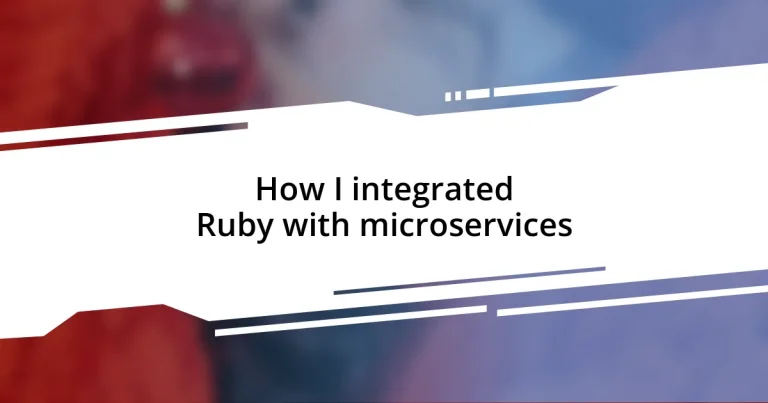Key takeaways:
- Ruby’s elegant syntax and vibrant ecosystem (gems) facilitate rapid development and simplify integration, making it ideal for microservices.
- Effective microservices design requires clear service responsibilities and robust communication protocols, with an emphasis on RESTful APIs.
- Implementing comprehensive testing frameworks, such as RSpec and contract testing with Pact, enhances reliability and reduces integration issues in microservices.
- Proactive monitoring and structured logging are essential for maintaining performance and quickly identifying issues in Ruby applications.
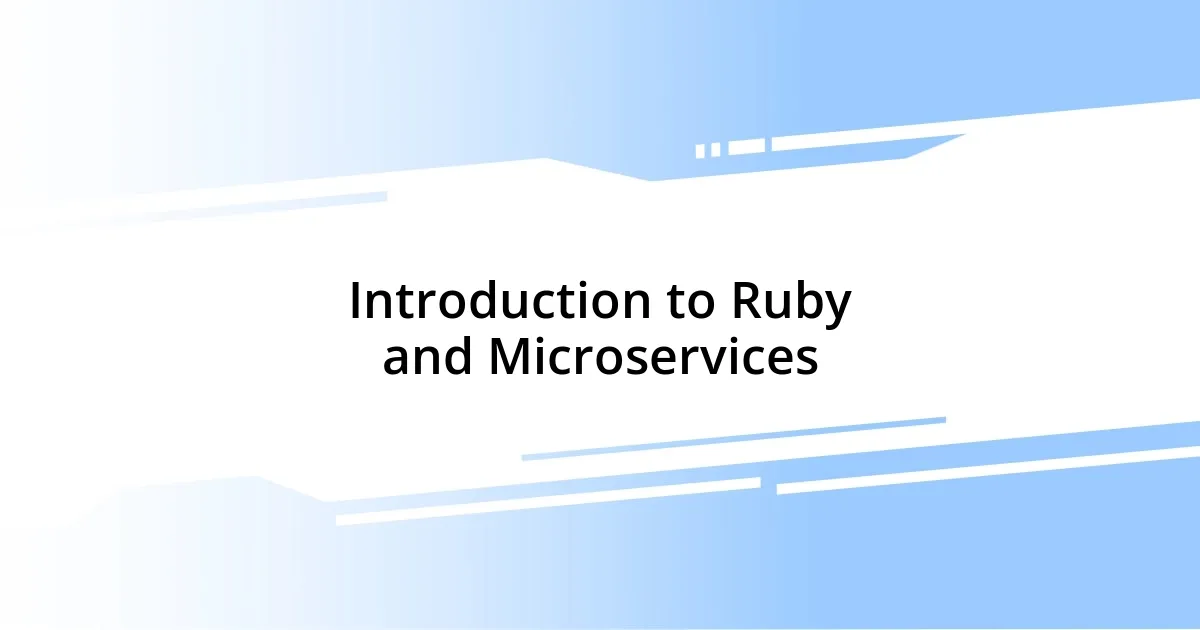
Introduction to Ruby and Microservices
Ruby is a powerful programming language that has garnered a lot of love from developers for its elegance and simplicity. I remember my first encounter with Ruby; it felt like discovering a new language that was almost poetic in its design. This human-centric approach to coding makes Ruby a great fit for creating microservices, where the ability to quickly iterate and adapt is crucial.
Microservices, on the other hand, break down applications into smaller, manageable services that can be developed, deployed, and scaled independently. When I first delved into microservices, I was both excited and intimidated by the prospect of architecting a system that could be so flexible yet complex. I often found myself pondering, how do you maintain coherence in such a fragmented environment?
Integrating Ruby with microservices not only leverages Ruby’s strengths but also addresses the unique challenges of microservice architecture. I’ve noticed that the natural readability of Ruby helps teams communicate effectively, reducing the friction often encountered in collaborative development. It’s almost like having a shared vocabulary that enhances our workflow—how can you put a price on that?

Benefits of Using Ruby
Ruby offers numerous benefits that are particularly advantageous when working within a microservices architecture. One of the standout features for me is Ruby’s elegant syntax, which allows for rapid development. I recall a project where the team’s productivity skyrocketed because we could prototype services in a fraction of the time compared to other languages. This speed can be a game-changer, especially when you’re racing against tight deadlines.
Another major benefit of using Ruby is its vibrant ecosystem and the availability of libraries, often referred to as gems. I remember integrating a gem for authentication that not only simplified the process but also kept our services secure. The community support is incredible, and it feels reassuring knowing that solutions are often just a gem away. This rich resource makes it easier to implement robust features without reinventing the wheel.
Moreover, Ruby’s flexibility allows developers to write clean, maintainable code. During one of my projects, I witnessed how refactoring code became a breeze, enabling us to adapt to new requirements without the usual headaches. This adaptability is invaluable in a microservices environment, where changes are frequent and should be handled gracefully. Ultimately, these benefits make Ruby an appealing choice for microservices.
| Benefit | Description |
|---|---|
| Elegant Syntax | Allows rapid development and prototyping. |
| Rich Ecosystem | Provides numerous libraries (gems) for features and security. |
| Flexibility | Enables clean, maintainable code, facilitating easy refactoring. |

Setting Up Ruby Environment
Setting up the Ruby environment is a crucial step that lays the groundwork for your microservices. I still remember the excitement mixed with a hint of nervousness I felt when configuring my first Ruby environment. It’s one of those moments where setting everything up perfectly feels like preparing a cozy nest for your new project. To ensure everything runs smoothly, here’s what I recommend:
- Install Ruby: I usually go for a version manager like RVM or rbenv. They make it easy to switch between Ruby versions, and I appreciate that flexibility.
- Choose a Code Editor: My personal favorite is Visual Studio Code. It has fantastic plugins that enhance Ruby development, making everything from syntax highlighting to debugging more intuitive.
- Set Up Bundler: I can’t stress enough how much Bundler simplifies managing your gems. Just running a single command makes dependency management a breeze.
- Create Your Project Structure: Starting with a well-organized directory layout gives your project clarity from day one. I tend to follow the MVC (Model-View-Controller) pattern, as it aligns well with microservices architecture.
- Use Docker: If you’re aiming for containerization, incorporating Docker early helps create a consistent development environment. I remember how much time I saved by avoiding “It works on my machine” scenarios.
While setting up, I haven’t just encountered technical hurdles but also a sense of achievement as I watched my environment come to life. Each step felt like laying the bricks for a solid foundation, and it’s incredibly satisfying to see everything work seamlessly.
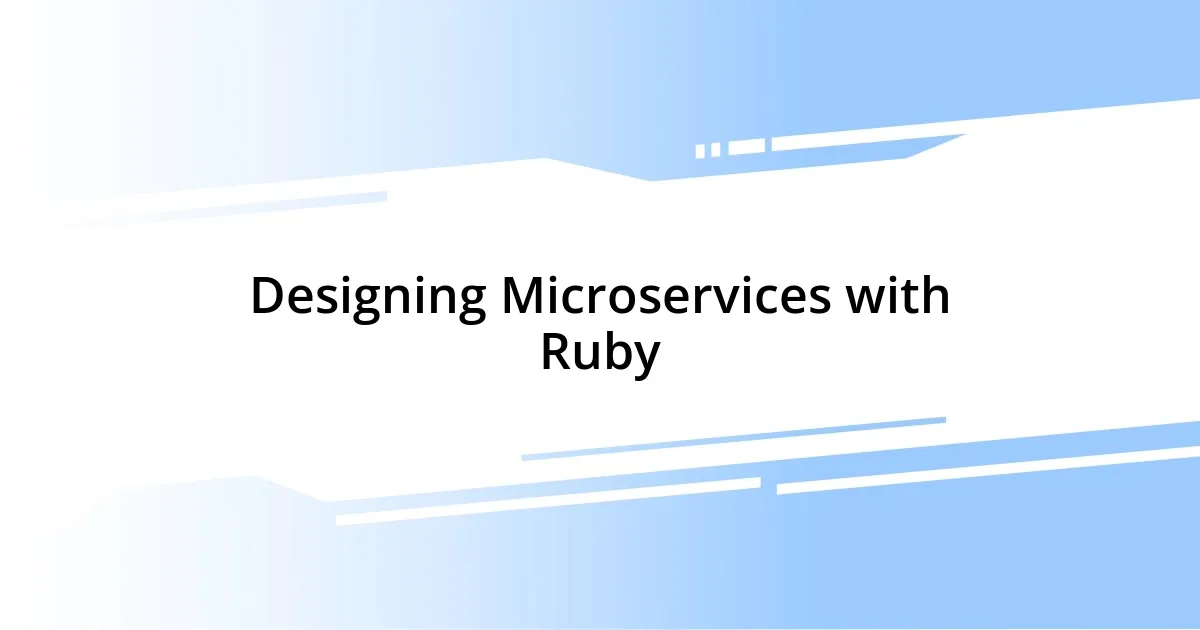
Designing Microservices with Ruby
When designing microservices with Ruby, one of the first considerations should be how you structure your services. I remember feeling a sense of clarity when I decided on a service-oriented architecture that broke down monolithic applications into distinct, manageable components. Each microservice should have its specific responsibility, which not only simplifies development but also makes debugging far less daunting. Have you ever felt overwhelmed by a bloated codebase? Splitting functionalities into smaller, dedicated services helps tackle that problem head-on.
Another aspect I found crucial was the communication between services. We chose to implement RESTful APIs for most of our interactions, but I was pleasantly surprised by how well Ruby on Rails allows for easy integration of other protocols, like GraphQL, if needed. In one instance, I facilitated communication between a payment system and our order service. The ability to experiment with different communication methods really highlighted how versatile Ruby can be in a microservices environment.
Lastly, addressing scalability became a priority as we expanded our services. Leveraging Ruby’s ability to pair with orchestration tools like Kubernetes was a game changer for us. I recall the relief I felt when I could automate deployment and scaling processes; it felt like finally getting a handle on the chaos. Have you encountered similar scaling challenges? Trust me, implementing these strategies can make a significant difference in your microservices’ efficiency and performance.
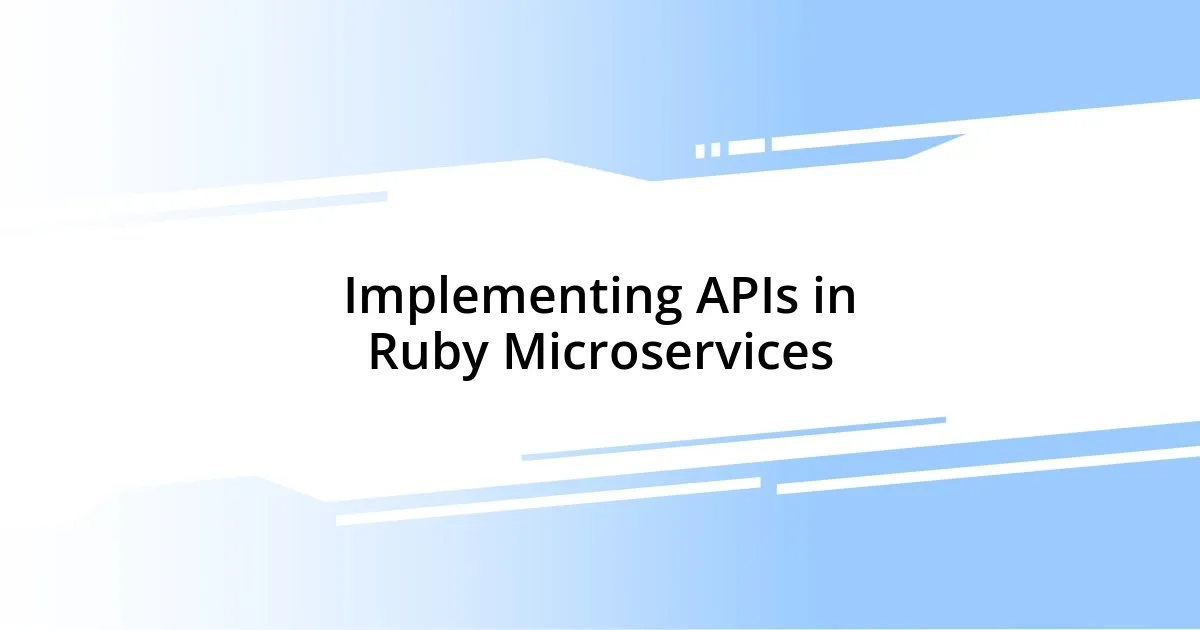
Implementing APIs in Ruby Microservices
When I first started implementing APIs in Ruby microservices, I was struck by the elegance of the framework. Using Ruby on Rails, I found that creating RESTful endpoints was surprisingly straightforward; it felt like painting with broad strokes on a canvas. I often recall the sense of accomplishment I had after building my first API, which served data seamlessly to our front end. Who knew that just a few lines of code could allow for such dynamic interactions between services?
One key decision I faced was whether to use JSON or XML for my data interchange. My gut led me toward JSON due to its lightweight nature and ease of use with JavaScript front ends. I remember a moment of realization during a team meeting when I noticed how the team’s productivity skyrocketed after we standardized on JSON. Have you ever felt that rush of clarity that accompanies a great decision? Simplifying our data format reduced confusion and made our APIs more intuitive, facilitating smoother interactions within our microservices architecture.
As I delved deeper into API implementation, security became an unavoidable focus. I was initially hesitant about adding authentication layers, thinking it would complicate our development flow. But once I integrated strategies like token-based authentication, I felt an overwhelming sense of security and trust in our system. Can your services afford to be vulnerable? Trust me, taking the time to secure your APIs is invaluable; it nurtures confidence not just in your code, but also in the relationships you build with your users.
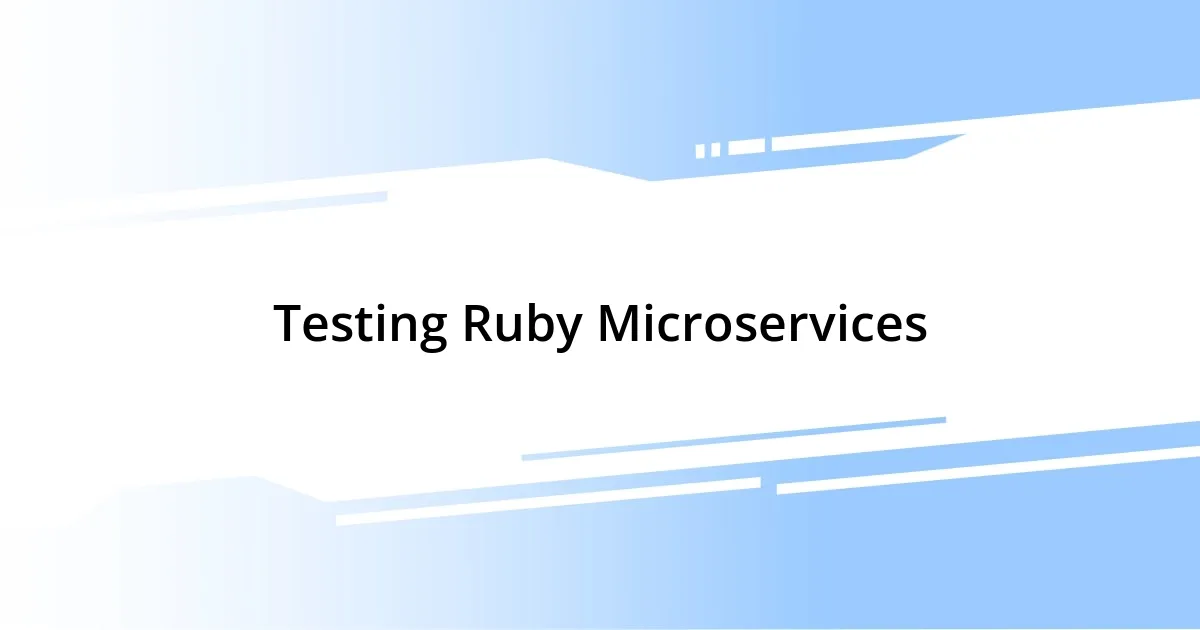
Testing Ruby Microservices
When it comes to testing Ruby microservices, I found that a solid testing framework is absolutely essential. Early in my journey, I gravitated towards RSpec for unit and integration tests because of its readable syntax. I still vividly remember the first time I ran my tests and saw that green light; it was a moment of sheer joy, knowing my code was behaving as expected. How do you ensure the reliability of your services?
I quickly realized that testing microservices is different from testing monolithic applications. Each service has its own lifecycle, which means testing becomes more complex. I recall spending many late nights working on end-to-end tests as we integrated multiple services. It was exciting yet challenging, especially when tracing failures through various service boundaries. Have you ever felt the rush of adrenaline while debugging a tricky issue that crossed service lines? Trust me, those moments sharpen your skills and deepen your understanding.
Another aspect I embraced was the idea of contract testing. It was a revelation when I stumbled upon Pact, a tool that allows services to agree on what to expect from each other. It significantly reduced integration headaches. I remember celebrating a successful release where all the contract tests passed without issues; it felt like we’d built a fortress around our microservices. Have you considered how eliminating assumptions between services can transform your confidence in deployment? It’s a game changer that can save you from unexpected surprises in production.

Monitoring and Maintaining Ruby Applications
Monitoring Ruby applications is a critical aspect of maintaining their performance and reliability. I remember the first time I integrated a monitoring tool, New Relic, into my Ruby microservices. The moment the dashboard lit up with performance metrics, it felt like finally being able to see under the hood of my services. I often ask myself, “What if I hadn’t implemented that? How many issues would I have missed?” Having real-time insights not only helped me identify bottlenecks but also allowed me to proactively address potential problems before they impacted users.
Logging plays a vital role in monitoring as well. Early on, I learned the value of structured logging with tools like Logstash. One evening, while combing through logs after a deployment issue, I stumbled upon a single log line that saved us from a major outage. It reminded me of the importance of clarity in our logs. Do your logs tell the story you need them to? Making sure that log entries are informative and easily searchable became one of my priorities, and it paid off when debugging incredibly complex microservices interactions.
Maintenance can often feel daunting, but I discovered that setting up a regular maintenance schedule really helps. The first time we implemented weekly reviews and updates, I could sense a shift in our team’s confidence. How many times have you faced issues that could have been avoided with preemptive action? Those scheduled check-ins not only allowed us to catch vulnerabilities early but also fostered a team culture of vigilance. It transformed maintenance from a chore into a collaborative effort that strengthened our system and our team.












